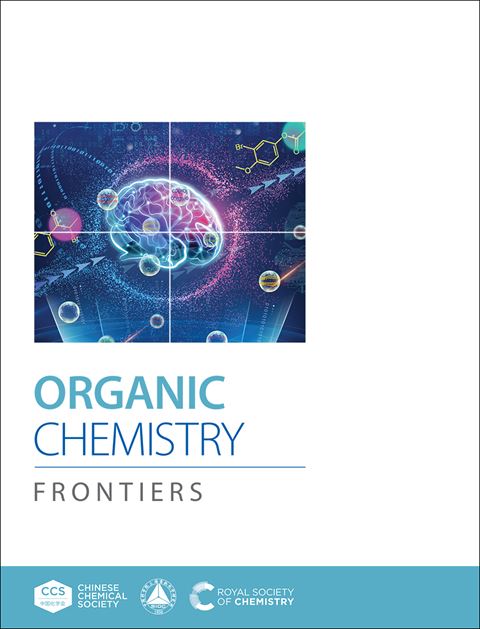1,5-氢原子转移介导的交叉脱氢偶联对羟肟酸衍生物的光氧化还原催化γ - C(sp3)−H乙烯化
IF 4.7
1区 化学
Q1 CHEMISTRY, ORGANIC
引用次数: 0
摘要
首次通过交叉脱氢偶联(CDC)反应,在可见光诱导下建立了羟肟酸衍生物与2-芳基酰胺的区域选择性γ-C(sp3)-H乙烯化反应。这种远端γ-乙烯基化是通过羟基肟酸衍生物的光催化N-O键裂解原位产生的酰胺基自由基的1,5-氢原子转移(1,5- hat)来实现的。本文章由计算机程序翻译,如有差异,请以英文原文为准。
Photoredox catalytic γ‑C(sp3)−H vinylation of hydroxamic acid derivatives via 1,5-hydrogen-atom-transfer-mediated cross-dehydrogenative coupling
A visible-light-induced regioselective γ-C(sp3)-H vinylation of hydroxamic acid derivatives with 2-aryl enamides was developed via cross-dehydrogenative coupling (CDC) reactions for the first time. This remote γ-vinylation was realized by the 1,5-hydrogen atom transfer (1,5-HAT) of the amidyl radicals that in situ generated through the potocatalytic N-O bond cleavage of hydroxamic acid derivatives.
求助全文
通过发布文献求助,成功后即可免费获取论文全文。
去求助
来源期刊

Organic Chemistry Frontiers
CHEMISTRY, ORGANIC-
CiteScore
7.90
自引率
11.10%
发文量
686
审稿时长
1 months
期刊介绍:
Organic Chemistry Frontiers is an esteemed journal that publishes high-quality research across the field of organic chemistry. It places a significant emphasis on studies that contribute substantially to the field by introducing new or significantly improved protocols and methodologies. The journal covers a wide array of topics which include, but are not limited to, organic synthesis, the development of synthetic methodologies, catalysis, natural products, functional organic materials, supramolecular and macromolecular chemistry, as well as physical and computational organic chemistry.
 求助内容:
求助内容: 应助结果提醒方式:
应助结果提醒方式:


